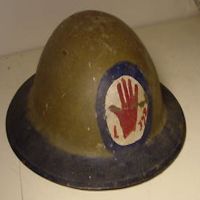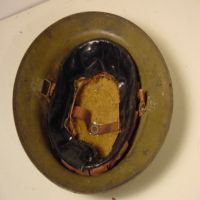Helmets
Brodie Helmet
The Brodie helmet, called Helmet, steel, Mark I helmet in Britain and the M1917 Helmet in the U.S., was a steel combat helmet designed and patented in 1915 by Englishman John Leopold Brodie. Colloquially, it was called the shrapnel helmet, Tommy helmet, Tin Hat, and in the United States the doughboy helmet. It was also known as the dishpan hat, tin pan hat, washbasin, battle bowler (when worn by officers), and Kelly helmet. The US version, the M1917, was copied from the British Mk 1 steel helmet of 1916. The German Army called it the Salatschüssel (salad bowl)
At about the same time, the British War Office had also seen a similar need for steel helmets. The War Office Invention Department was ordered to evaluate the French design. They decided that it was not strong enough and too complex to be swiftly manufactured. British industry was not geared up to an all-out effort or war production in the early days of World War I, which also led to the shell shortage of 1915.
A design patented in 1915 by John L. Brodie of London offered advantages over the French design. It was constructed from a single piece that could be pressed from a single thick sheet of steel, giving it added strength.
Brodie's design resembled the medieval infantry kettle hat or chapel-de-fer, unlike the German Stahlhelm, which resembled the medieval sallet. It had a shallow circular crown with a wide brim around the edge, a leather liner, and a leather chinstrap. The helmet's "soup bowl" shape was designed to protect the wearer's head and shoulders from Shrapnel shell projectiles bursting from above the trenches. The design allowed the use of relatively thick steel that could be formed in a single pressing while maintaining the helmet's thickness. This made it more resistant to projectiles, but it offered less protection to the lower head and neck than other helmets.
The original design (Type A) was made of mild steel with a brim 1.5 to 2 inches wide. The Type A was in production for just a few weeks before the specification was changed and the Type B was introduced in October 1915. The specification was altered at the suggestion of Sir Robert Hadfield to a harder steel with 12% manganese content, which became known as "Hadfield's steel", which was virtually impervious to shrapnel balls, provided they impacted from above. Ballistically this increased protection for the wearer by 10 percent, and could withstand a .45 caliber pistol bullet traveling at 600 feet per second fired at a distance of 10 feet. It also had a narrower brim and a more domed crown.
That same month the first delivery of the helmets was made to British Army troops. Initially, there were far from enough helmets to equip every man, so they were designated as "trench stores", to be kept in the front line and used by each unit that occupied the sector. It was not until the summer of 1916, when the first one million helmets had been produced, that they could be generally issued.
The Brodie helmet reduced casualties, but was criticized by General Herbert Plumer on the grounds that it was too shallow, too reflective, its rim was too sharp, and its lining was too slippery. These criticisms were addressed in the Mark I model helmet of 1916, which had a separate folded rim, a two-part liner, and matte khaki paint finished with sand, sawdust, or crushed cork to give a dull, non-reflective appearance. In 1917 the liner was modified to include a rubber cushion to make it more comfortable, although this was not adopted for the M1917. Helmets were often painted with unit insignia towards the end of the war, and are often called "parade helmets" by collectors.
The weight of a Mark I helmet was approximately 1.3 pounds (0.59 kg).
M-15 Adrian Helmet
At the outbreak of World War I soldiers in the French army wore the standard kepi cap, which provided no protection against injury. The early stages of trench warfare proved that even basic protection of the head would result in a significantly lower mortality rate among front-line soldiers. Consequently, the French staff ordered development of a metal helmet that could protect soldiers from the shrapnel of exploding artillery shells. Since soldiers in trenches were also vulnerable to shrapnel exploding above their heads, a deflector crest was added along the helmet's axis. Branch insignia in the form of a grenade for line infantry and cavalry, a bugle horn for chasseurs, crossed cannon for artillery, an anchor for colonial troops and a crescent for North African units was attached to the front. Contrary to common misconception, the M15 helmet was not designed to protect the wearer from direct impact by rifle or machine gun bullets. The resulting headgear was credited to Intendant-General August-Louis Adrian.
read more Back to UNIFORMS PAGE


